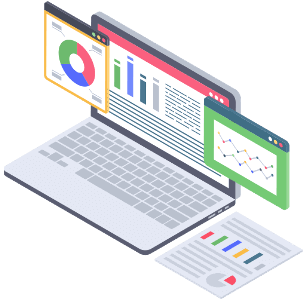 Welcome to Thesis-Dissertation Writing Services, your ultimate destination for comprehensive data analysis solutions. In today's rapidly evolving landscape, where data reigns supreme, the ability to glean meaningful insights from vast pools of information is a game-changer. This is where we step in – empowering businesses and individuals alike to make informed decisions, optimize strategies, and unlock the true potential of their projects. We understand that the modern world operates on data-driven decisions. Our mission is to simplify the complex process of data analysis and offer tailored solutions that cater to your unique needs. Whether you're a startup aiming to understand market trends, a research team seeking patterns in scientific data, or a corporate entity wanting to enhance operational efficiency, our services are designed to serve your goals. By entrusting us with your data analysis needs, you open the doors to a multitude of benefits. Our team of skilled data analysts possesses a deep understanding of various industries and the tools needed to extract actionable insights from raw data. We streamline the analysis process, saving you precious time and resources, while ensuring accuracy and reliability in our findings. Our commitment to client satisfaction drives us to deliver not just results, but meaningful and understandable interpretations of your data. We believe that every data point has a story to tell, and our expertise lies in translating those stories into opportunities for growth and innovation. With us, you can embark on a journey toward data-driven success. Let us empower you to harness the full potential of your projects through our expert help with analyzing project data. Your data has a story, let's unfold it together.
Welcome to Thesis-Dissertation Writing Services, your ultimate destination for comprehensive data analysis solutions. In today's rapidly evolving landscape, where data reigns supreme, the ability to glean meaningful insights from vast pools of information is a game-changer. This is where we step in – empowering businesses and individuals alike to make informed decisions, optimize strategies, and unlock the true potential of their projects. We understand that the modern world operates on data-driven decisions. Our mission is to simplify the complex process of data analysis and offer tailored solutions that cater to your unique needs. Whether you're a startup aiming to understand market trends, a research team seeking patterns in scientific data, or a corporate entity wanting to enhance operational efficiency, our services are designed to serve your goals. By entrusting us with your data analysis needs, you open the doors to a multitude of benefits. Our team of skilled data analysts possesses a deep understanding of various industries and the tools needed to extract actionable insights from raw data. We streamline the analysis process, saving you precious time and resources, while ensuring accuracy and reliability in our findings. Our commitment to client satisfaction drives us to deliver not just results, but meaningful and understandable interpretations of your data. We believe that every data point has a story to tell, and our expertise lies in translating those stories into opportunities for growth and innovation. With us, you can embark on a journey toward data-driven success. Let us empower you to harness the full potential of your projects through our expert help with analyzing project data. Your data has a story, let's unfold it together.
Our key steps involved in providing effective project data analyzing services
Data Collection and Cleaning: The initial phase involves the meticulous gathering of relevant data from various sources. This data might include financial records, customer behavior patterns, market trends, and more. Subsequently, the collected data is subjected to a thorough cleansing process to eliminate inconsistencies, errors, and outliers.
- Data Transformation: Once the data is cleaned, it needs to be transformed into a suitable format for analysis. This step involves converting raw data into structured datasets, making it amenable to various analytical techniques.
- Exploratory Data Analysis (EDA): EDA is a crucial step that involves identifying patterns, relationships, and anomalies within the dataset. It aids in forming hypotheses and generating insights that steer the direction of the analysis.
- Application of Statistical Techniques: Statistical methods are employed to unearth deeper insights from the data. Descriptive and inferential statistics help in drawing meaningful conclusions and making predictions with a certain level of confidence.
- Data Visualization: Communicating complex findings effectively is vital. Data visualization techniques such as graphs, charts, and dashboards are used to present insights in a visually engaging manner, making it easier for stakeholders to comprehend.
- Predictive Modeling: For projects aiming to anticipate future trends or outcomes, predictive modeling techniques like regression analysis and machine learning algorithms are applied. These models use historical data to forecast future scenarios.
- Interpretation and Reporting: The final step involves translating the analysis into actionable insights. A comprehensive report is generated, highlighting key findings, recommendations, and potential areas for improvement.
The significance of data analysis in conveying project insights
Data analysis is the bridge between raw data and informed decision-making. Its significance lies in:
- Evidence-Based Decision-Making: Rather than relying on gut feelings or assumptions, data analysis empowers decision-makers with factual insights, reducing the risk of making misguided choices.
- Identifying Opportunities and Challenges: Effective data analysis can uncover hidden opportunities within a project, as well as potential challenges that might have otherwise gone unnoticed.
- Resource Optimization: By analyzing historical data, project managers can allocate resources more efficiently, ensuring that budgets, time, and manpower are used optimally.
- Measuring Progress: Regular data analysis allows for tracking the progress of a project, ensuring that it stays aligned with goals and making adjustments as needed.
How project data analysis solutions contribute to achieving better results
Data analysis solutions provide accurate and detailed insights, enabling stakeholders to make well-informed decisions based on evidence rather than conjecture. With advanced data analysis tools, projects can be monitored in real-time, enabling swift reactions to changing circumstances and avoiding potential pitfalls. More so, by analyzing project data throughout its lifecycle, areas that need improvement can be identified, leading to iterative enhancements for better results. Data analysis solutions aid in identifying potential risks early on, allowing for proactive measures to mitigate their impact. Furthermore, data analysis platforms facilitate collaboration among project teams and stakeholders by providing a shared platform to access, interpret, and discuss findings.
Our services are integral to modern project management and decision-making processes. If you follow key steps in data analysis, you can unlock valuable insights, make informed decisions, and ultimately achieve superior results. The significance of data analysis in conveying project insights cannot be overstated as it empowers organizations to leverage their data as a strategic asset, fostering innovation and growth in an increasingly competitive landscape. Through the use of advanced data analysis solutions, projects gain a competitive edge, optimizing resources, managing risks, and driving success.
Help to Analyze my Project Data | Statistical Analysis Services
 In today's data-driven landscape, deriving meaningful insights from project data has become paramount for informed decision-making and strategic planning. Welcome to our reliable platform, where we specialize in offering top-notch project data analysis assistance to comprehensively analyze data. In the realm of business, academia, and research, the value of accurate and insightful data analysis cannot be overstated. It's not enough to merely collect data; the real essence lies in transforming raw information into actionable insights that can steer projects toward success. This is precisely where our expertise shines. Our dedicated team of skilled statisticians and data analysts is committed to unraveling the hidden patterns, trends, and correlations within your project data. With a wealth of experience and a deep understanding of various statistical methodologies, we employ advanced techniques to dissect your data and extract valuable insights that might otherwise go unnoticed. We recognize that every project is unique, presenting its challenges and opportunities. That's why our approach is tailored to your specific requirements, ensuring that our analysis aligns seamlessly with your project goals. Whether you're facing intricate business dilemmas, pursuing academic endeavors, or driving groundbreaking research, our statistical analysis services stand ready to provide the support you need. Partner with us to unlock the true potential of your project data. By choosing our services, you're not only gaining access to cutting-edge analysis techniques but also empowering yourself with the knowledge to make informed decisions and propel your projects to new heights.
In today's data-driven landscape, deriving meaningful insights from project data has become paramount for informed decision-making and strategic planning. Welcome to our reliable platform, where we specialize in offering top-notch project data analysis assistance to comprehensively analyze data. In the realm of business, academia, and research, the value of accurate and insightful data analysis cannot be overstated. It's not enough to merely collect data; the real essence lies in transforming raw information into actionable insights that can steer projects toward success. This is precisely where our expertise shines. Our dedicated team of skilled statisticians and data analysts is committed to unraveling the hidden patterns, trends, and correlations within your project data. With a wealth of experience and a deep understanding of various statistical methodologies, we employ advanced techniques to dissect your data and extract valuable insights that might otherwise go unnoticed. We recognize that every project is unique, presenting its challenges and opportunities. That's why our approach is tailored to your specific requirements, ensuring that our analysis aligns seamlessly with your project goals. Whether you're facing intricate business dilemmas, pursuing academic endeavors, or driving groundbreaking research, our statistical analysis services stand ready to provide the support you need. Partner with us to unlock the true potential of your project data. By choosing our services, you're not only gaining access to cutting-edge analysis techniques but also empowering yourself with the knowledge to make informed decisions and propel your projects to new heights.
What are your specific goals for the project data statistical analysis?
Before diving into statistical analysis, it's essential to define your project's goals. What questions do you want to answer? What problems are you trying to solve? Clear goals provide direction and purpose to your analysis. Whether you're aiming to understand customer behavior, optimize resource allocation, or evaluate project performance, having well-defined objectives ensures that your analysis aligns with your project's needs. At this juncture, it's suitable to send us a quote reading “help to analyze my project data” to easily meet your objectives.
What are the insights you gain through project data exploration?
Project data exploration is the initial step where you become familiar with your data's characteristics. Descriptive statistics, data visualization, and preliminary analysis help you understand the distribution of variables, identify outliers, and detect trends. This phase often leads to valuable insights such as:
- Patterns and Trends: Discover patterns in project timelines, resource utilization, or user engagement that might have been overlooked. Visualizations like line charts, scatter plots, and heatmaps can reveal trends that inform your decision-making.
- Correlations: Statistical analysis can unveil relationships between different variables. For instance, you might find that higher marketing expenditures are correlated with increased sales during certain periods. These insights guide resource allocation strategies.
- Anomalies: Outliers can indicate anomalies or exceptional events. Investigating outliers can help you understand what led to those unique occurrences and whether they provide opportunities or pose risks.
The limitations to consider when conducting project data statistical analysis
While statistical analysis is a powerful tool, it's important to recognize its limitations to ensure accurate and informed decision-making. The reliability of insights heavily depends on data quality. Inaccurate or incomplete data can lead to misleading conclusions. Ensure your data is clean, consistent, and representative of the project's reality. Also, statistical analysis can show relationships between variables, but it doesn't prove causation. Correlation doesn't necessarily imply one variable causes the other. Additional research and domain knowledge are often needed to establish causal relationships. Needless to say, if your data sample isn't representative of the entire project population, your findings might not generalize well. Be cautious when drawing conclusions based on a limited subset of data. furthermore, many statistical methods have underlying assumptions. Violating these assumptions can lead to inaccurate results. Understand the assumptions of the techniques you're using and check if they hold for your data. Statistical analysis can't replace human judgment and domain expertise. Always interpret the results within the broader context of your project's goals and the industry landscape.
Project data statistical analysis can provide invaluable insights that inform strategic decisions. Defining clear goals, exploring data thoroughly, and understanding limitations are essential steps to ensure the accuracy and relevance of your analysis. Remember that statistical analysis is a dynamic process that requires iterative exploration and refinement. By embracing these principles, you can harness the power of data to drive your project's success.





 In the ever-evolving landscape of data-driven decision-making, the role of
In the ever-evolving landscape of data-driven decision-making, the role of  We guarantee you the
We guarantee you the 